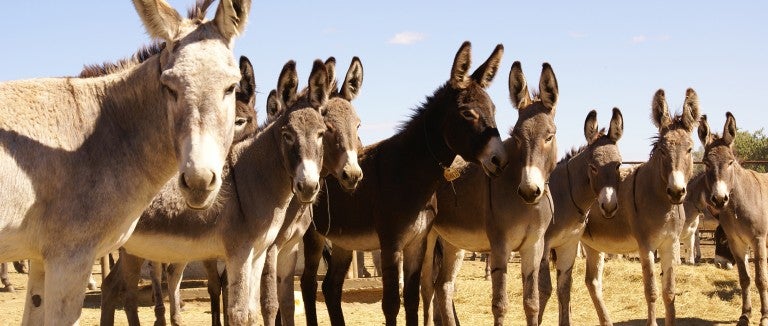Fertility control: Essential to American wild burros and mustangs
While wild burros are legally viewed in the same light as the American mustang, protected as a living symbol of the American West, the wild horses often seem to receive most of the public's attention. But burros have played a critical role in the development of the West, and they now face similar threats. The Platero Project was created to shed some much-deserved light on their plight.
For 20 years, the Bureau of Land Management's primary strategy for dealing with wild burro and horse populations has largely consisted of rounding up and removing the animals from public lands and placing them in government holding facilities. Today, tens of thousands of wild equines are kept in holding facilities, costing taxpayers nearly $50 million a year and eating up more than half of the BLM's annual budget for its entire wild horse and burro program. Partly because those direct care costs are so great, the agency is unable to commit the level of funding that the HSUS believes would be necessary to implement sufficient fertility control programs, which have been long recommended by the HSUS and the National Academies of Sciences.
The HSUS believes that the strategic, widespread use of fertility control is the only way to address this crisis in the long term and provides a way to do it humanely. Fertility control works, but only if there's a serious investment in the enterprise on the ground.
A new way forward
The Platero Project—a collaboration between the HSUS and the BLM—aims to assess the feasibility of using fertility control to help manage the burro population in the Black Mountain Herd Management Area in northwestern Arizona. The four-year pilot project, started in August of 2017, is financed by an HSUS donor and a supplementary grant from the BLM, and is named for the Spanish Nobel Laureate Juan Ramon Jimenez's beautiful book about a faithful and friendly burro named Platero.
The fertility control program focuses on female burros (called jennies) who are treated with ZonaStat-H (also known as Porcine Zona Pellucida or PZP), a fertility control vaccine that temporarily stalls reproduction. Males (called jacks) are set free after the teams take hair samples from their tails (to mark the males previously captured and test for genetic diversity).

The Platero Project timeline
During the first year of the Platero Project, the HSUS worked with BLM to capture 109 jennies, including eight or so jennies living around the historic mining town of Oatman, which have become so habituated to human presence and feeding that they no longer stay away from people. The Black Mountain Herd Management Area is a striking but forbidding landscape, home to very wild and highly alert burros (with the exception of the human-habituated jennies near Oatman). The model the HSUS hopes to establish here has great promise: If fertility control can be effectively administered to the animals here and the results are good, it's a model that should be replicable at other burro management areas.
The HSUS believes that only when BLM goes all in on fertility control will the nation have a viable, fiscally sound and effective strategy for humanely managing wild horses and burros. The idea of mass slaughter or euthanasia will never be acceptable to the American public, nor should it. Fertility control, in combination with selective gathers and more effective adoption programs, is the only viable path forward. The work being done through the Platero Project is the latest to show that these strategies will work on the ground to manage wild burro populations. They can become a model, one that the HSUS hopes will gain support from senior leaders at the BLM and Congress. With more buy-in, this approach can spread across other wild burro herd management areas and effect change on a national scale.
The views and conclusions contained on this webpage are those of the authors and should not be interpreted as representing the opinions or policies of the U.S. Government. Mention of trade names or commercial products does not constitute their endorsement by the U.S. Government.
